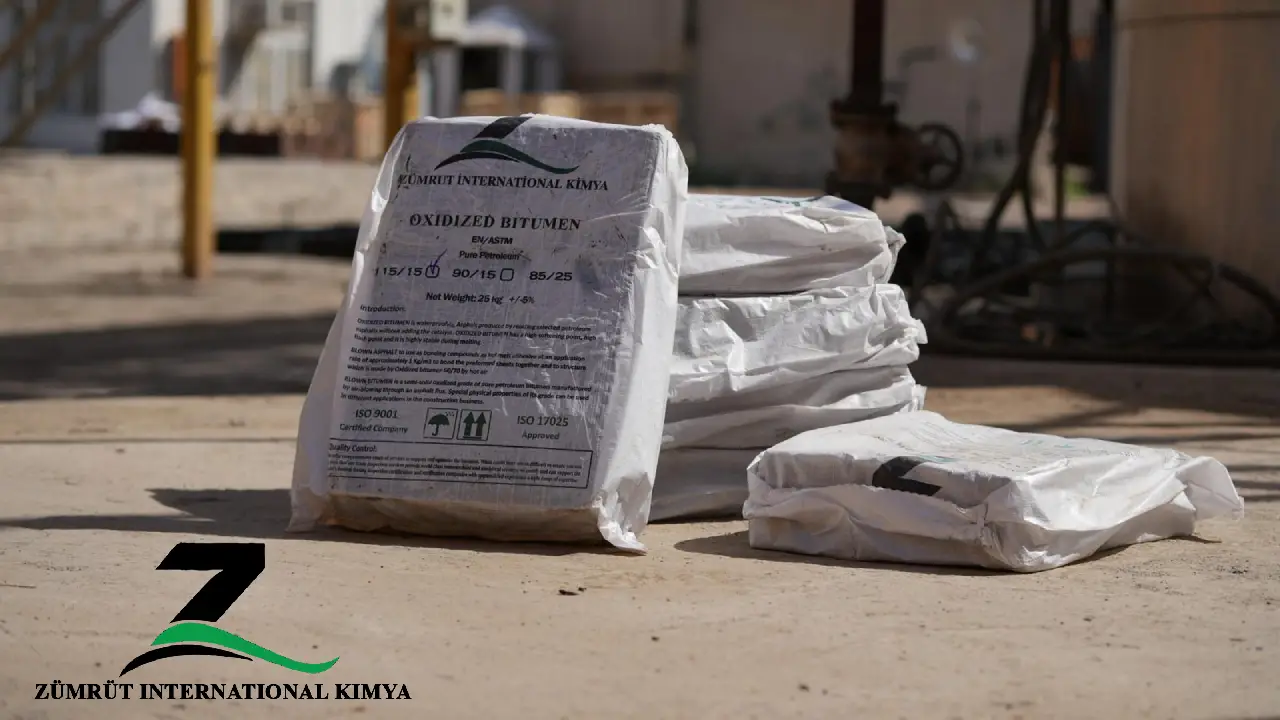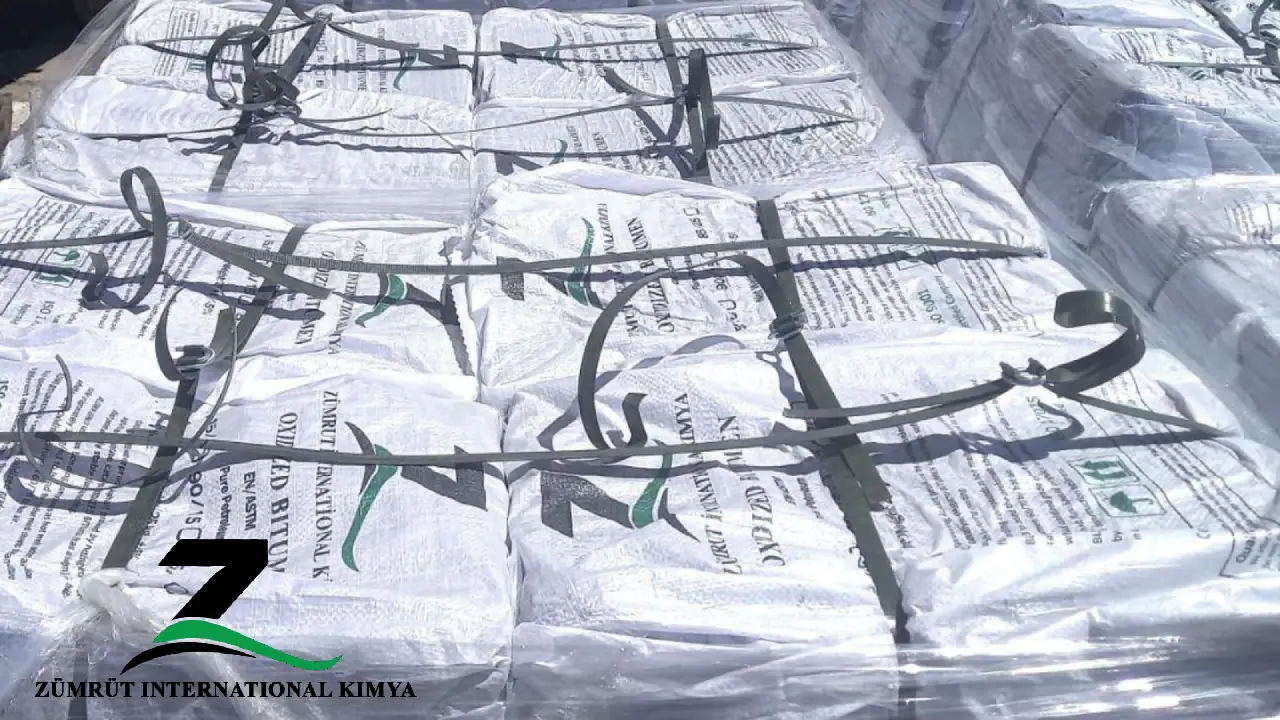
Description of Oxidized Asphalt 105/35
Oxidized Asphalt 105/35 is a type of asphalt binder commonly used in road construction and maintenance. It’s produced by blowing air through heated asphalt to increase its viscosity and improve its resistance to aging and weathering. The “105/35” designation refers to its penetration and softening point characteristics, with 105 indicating the penetration value in tenths of a millimeter at 25°C, and 35 indicating the softening point in degrees Celsius.
ZUMRUT Company is one of the market leaders in Production, Exports, and brokerage different grades of Blown Asphalt with excellent quality. Our sales team is committed who understands your requirements due to many years of experience in supplying the bitumen products. If you are more interested in product information or need to place an order contact or inquire our Sales team.
Blown Asphalt 105/35 Applications
Oxidized Bitumen 105/35 is widely used in various applications in road construction and maintenance. Some common applications include:
- Surface treatments: It can be used as a binder in surface treatments like chip seals and slurry seals to provide a durable and weather-resistant surface for roads.
- Asphalt mixtures: It can be incorporated into hot mix asphalt (HMA) or warm mix asphalt (WMA) to enhance the performance and longevity of asphalt pavements.
- Roofing: Oxidized bitumen 105/35 is also used in roofing applications as a waterproofing material for flat or low-sloped roofs.
- Crack sealing and patching: It can be used for crack sealing and patching to repair damaged asphalt pavement and prevent further deterioration.
- Joint sealing: It is commonly used for sealing joints in concrete pavements and asphalt overlays to prevent water infiltration and reduce pavement distress.
Blown Asphalt 105/35 should be heated double temperature against the softening point to be able to have flow and viscosity. To use blown bitumen 105/35, surfaces must be dry, clean and free of loose particles, formwork, curing products, irregularities, slurry, etc.
Why should we use Oxidized Asphalt 105/35
Oxidized Asphalt 105/35 (or Blown Bitumen 105/35) is a specialized product with unique properties that make it ideal for various industrial applications. Here are some reasons why it is commonly used:
- High Softening Point
Oxidized Asphalt 105/35 has a higher softening point compared to regular bitumen, making it suitable for applications where the material is exposed to higher temperatures. This prevents it from becoming too soft or flowing under heat, enhancing its durability. - Improved Oxidation Resistance
The oxidation process enhances the material’s resistance to environmental conditions such as UV exposure, air, and moisture. This makes it more durable for roofing, waterproofing, and industrial applications where longevity is essential. - Elasticity and Flexibility
This type of oxidized bitumen retains some flexibility even in cooler temperatures. This flexibility helps in applications such as joint filling or crack sealing, as it can expand and contract with temperature changes without cracking. - Excellent Adhesion
Oxidized Asphalt 105/35 provides strong adhesion to various substrates like concrete, metal, or wood. This makes it suitable for waterproofing, undercoating, and adhesive applications where bonding strength is crucial. - Chemical Resistance
The material shows good resistance to chemicals and oils, making it a reliable option in industrial environments where chemical exposure might be a concern, such as in pipe coating and tank lining. - Enhanced Stability
Its thermal stability and resistance to softening at elevated temperatures make it ideal for insulation, roofing membranes, and paving applications where consistent performance is needed across varying conditions. - Waterproofing Abilities
Oxidized Asphalt 105/35 is highly effective in waterproofing applications, protecting structures from water damage and ensuring long-term resilience in roofing systems, tunnels, bridges, and basements.
Technical Advantages of Oxidized Asphalt 105/35
Oxidized Asphalt 105/35 offers several technical advantages, including:
- Enhanced durability: The oxidation process increases the asphalt’s resistance to aging, weathering, and traffic loads, resulting in a longer service life for pavement surfaces.
- Improved viscosity: The increased viscosity of oxidized asphalt 105/35 makes it better suited for high-temperature environments, reducing the risk of rutting and deformation in hot climates.
- Superior adhesion: Oxidized asphalt 105/35 forms strong bonds with aggregate particles, resulting in improved adhesion and cohesion in asphalt mixtures, which enhances pavement stability and performance.
- Reduced temperature susceptibility: The higher softening point of oxidized asphalt 105/35 reduces its susceptibility to temperature fluctuations, minimizing thermal cracking and rutting in asphalt pavements.
- Enhanced waterproofing: Oxidized asphalt 105/35 has excellent waterproofing properties, making it ideal for sealing cracks and joints in pavements and for use in roofing applications to prevent water infiltration.
Packing of Oxidized Asphalt 105/35
ZUMRUT Co is the manufacturer of oxidized Asphalt 105/35 in various packing, including bitumen 105/35 is available in 20 & 50 kg Kraft Paper Bags / Poly Amide Bags, 25 kg Carton box & 150, 180, 200 Kg Steel Drums. In addition, oxidized bitumen packing also palletize, 40 bags can stack on the pallet. 20 pallet can load to the 20ft container.

Storage and Handling Blown Asphalt 105/35
Proper storage and handling of Oxidized Asphalt 105/35 are crucial to maintain its quality and ensure safety. Here are some guidelines:
- Storage conditions: Store oxidized asphalt 105/35 in a well-ventilated, dry area away from direct sunlight, heat sources, and ignition hazards. Ideally, maintain storage temperatures between 15°C and 35°C (59°F to 95°F) to prevent excessive heating or cooling.
- Handling precautions: When handling oxidized asphalt, use appropriate personal protective equipment (PPE), including gloves, safety glasses, and protective clothing, to avoid skin contact and inhalation of fumes. Avoid prolonged exposure to vapors and fumes by working in well-ventilated areas or using respiratory protection if necessary.
- Heating and melting: If the oxidized asphalt solidifies during storage or transport, gently heat it using a heating blanket or hot oil bath to soften it for handling and application. Avoid overheating or exposing the asphalt to open flames, as this can cause combustion or degradation of the asphalt.
- Mixing and application: Mix oxidized asphalt 105/35 thoroughly before use to ensure uniform consistency and performance. Follow recommended application temperatures and procedures provided by the manufacturer for specific construction applications, such as paving, sealing, or roofing.
- Spill and leak containment: In the event of a spill or leak, contain the spilled material using absorbent materials like sand or clay to prevent environmental contamination. Dispose of contaminated materials properly according to local regulations.
Health & Safety of Oxidized Asphalt 105/35
Ensuring health and safety when handling Oxidized Asphalt 105/35 is paramount due to potential hazards associated with asphalt products. Here are some key health and safety considerations:
- Skin contact: Direct contact with oxidized asphalt can cause irritation or dermatitis. It’s essential to wear appropriate protective clothing, including gloves and long sleeves, to prevent skin exposure. If skin contact occurs, wash the affected area thoroughly with soap and water.
- Inhalation: Inhalation of vapors and fumes from heated or melted asphalt can irritate the respiratory tract and may cause headaches, nausea, or dizziness. Work in well-ventilated areas and use respiratory protection, such as masks or respirators, if ventilation is inadequate.
- Eye contact: Contact with asphalt fumes or splashes can irritate the eyes and may cause redness, tearing, or discomfort. Wear safety goggles or glasses to protect against eye exposure, and flush eyes with water if contact occurs.
- Combustibility: Asphalt products are flammable and can ignite at high temperatures. Avoid open flames, sparks, or smoking near storage or handling areas. Use appropriate fire suppression equipment and procedures to control fires or spills involving asphalt.
- Environmental impact: Spills or leaks of oxidized asphalt can contaminate soil, water bodies, and vegetation, leading to environmental damage. Take measures to contain and clean up spills promptly using absorbent materials and follow proper disposal procedures to prevent environmental contamination.
- Training and awareness: Ensure that personnel handling oxidized asphalt are trained in safe handling practices and aware of potential hazards. Provide safety data sheets (SDS) and instructions for proper storage, handling, and emergency response procedures.
By prioritizing health and safety measures, including proper personal protective equipment (PPE), ventilation, and spill containment, you can minimize risks associated with handling Oxidized Asphalt 105/35 and promote a safe working environment.
Technical Datasheet of Oxidized Asphalt 105/35
ZUMRUT Co guaranty the quality to meet with ASTM/EN 13304:2009
| CHARACTERISTIC | Test method | Unit | Specification |
| Specific gravity @25/25 C | ASTM D70 | (Kg/m3) | 1.05 approx. |
| Penetration @ 25°c | ASTM D5 | mm/10 | 30/40 |
| Softening point °c | ASTM D36 | °C | 100/110 |
| Loss on heating(wt) % | ASTM D6 | Wt. % | 0.2 max |
| Flashpoint c | ASTM D92 | °C | 250 min |
| Solubility is CS2(wt) % | ASTM D4 | Wt. % | 99.5 max |
| Specific gravity @25/25 C | ASTM D70 | (Kg/m3) | 1.05 approx. |
Technical Data Sheet of Oxidized Bitumen 105-35



